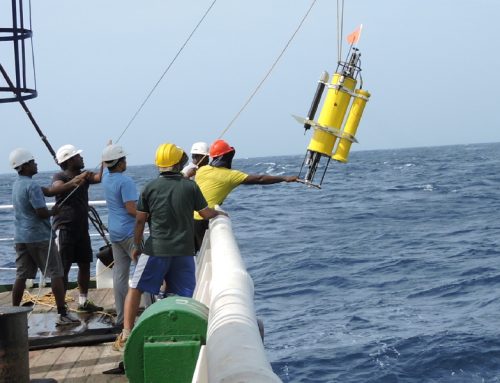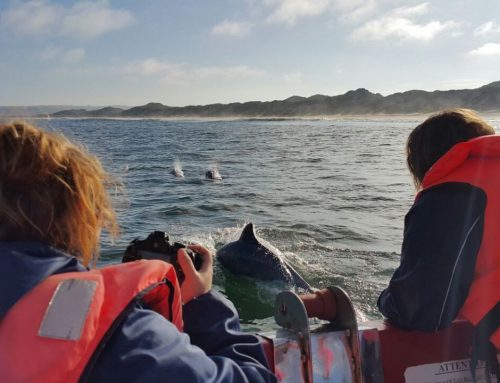 The first Protected Environment in the Karoo, Eastern Cape, has been proclaimed. Called the Compassberg Protected Environment it is a critical water catchment area spanning 42 000 hectares of livestock and game farms, and including the iconic Compassberg.
The first Protected Environment in the Karoo, Eastern Cape, has been proclaimed. Called the Compassberg Protected Environment it is a critical water catchment area spanning 42 000 hectares of livestock and game farms, and including the iconic Compassberg.
“It’s very exciting. It’s a first for the Eastern Cape and it is definitely the way forward for conservation – where private landowners such as those in the Compassberg Protected Environment (CPE) become biodiversity custodians while continuing their farming enterprises,” commented the CEO of the Eastern Cape Parks & Tourism Agency (ECPTA), Sybert Liebenberg after the proclamation of the CPE was signed by the Eastern Cape’s MEC of Economic Development, Environmental Affairs and Tourism, Mr Mcebisi Jonas, and published in the government gazette on the 6 July this year.
The CPE is situated between Nieu Bethesda and Middelburg in the Sneeuberg – a prominent mountain range of the Karoo’s Great Escarpment. Eight conservation-conscious livestock and game farmers came together to create the CPE in this Afro-montane belt comprising escarpment grassland and Karoo shrub.
The common aim is to protect and conserve this critical water catchment area, which includes one of South Africa’s natural treasures: the Compassberg. This distinctive geological feature that towers 2500m above sea level, is the highest peak in South Africa west of the Maluti-Drakensberg mountain range.
The Compassberg was covered in snow at the time of the proclamation, as was the rest of the CPE where it snows several times every winter and where temperatures frequently plummet below zero. It’s a magnificent landscape but it is no country for the meek, as the farmers here well know. The first meeting after the proclamation of the CPE in July was almost cancelled due to iced roads, but everyone soldiered through to ‘The Rest’ – the livestock farm owned by CPE Chairperson Paula Kingwill’s family – to discuss the CPE’s strategic management plan.
Cold is critical to the CPE’s watershed role, as Dr Dave Balfour, Executive Director: Biodiversity Conservation at ECPTA explains: “Not only is the CPE’s rainfall higher but the temperature, especially during winter, is lower than the surrounding areas. This is important in a region where evaporation is in the order of 10mm a day. The top of the catchment is able to retain water that has fallen in autumn (the long-term rainfall peak for the area) through to spring. This retention of water enables subsurface flow, groundwater penetration and recharge to occur in the surrounding areas.”
In addition to this, the CPE holds the watersheds and upper catchments of the Klein Zeekoei River, the Klein Brak River and the Diepkloof River. These feed into the Orange River, the Great Fish River and the Sundays River respectively – three of the most important river systems in South Africa. It supplies clean water to the surrounding towns of Middelburg, Nieu Bethesda, Graaff-Reinet and Richmond.
“It is a major source of water in a water scarce region, and the conservation, restoration and good management of this upper catchment is very important,” adds Dr Balfour whose role is to expand and oversee the areas in the Eastern Cape under conservation management. The CPE falls into this realm.
Sound veld management and species conservation is high on the list of priorities in the CPE, which conserves a large, unique altitudinal gradient extending from 1400-2500m. Recognised as a centre of endemism, more than 1200 flowering plant species have been recorded in the greater Sneeuberg area, 33 of which are endemic and 13 are near endemics.
“Within the CPE there are at least two species of special concern Euryops petraeus and Selago retropillosa, both of which are listed as ‘Rare’ and known nowhere else. Conservation of the CPE will significantly contribute to the conservation of montane endemics.
The Compassberg also has a snake and butterfly species that occur nowhere else in the world, notably the plain adder (Bitis inornata) and the Compassberg Skolly (Thestor compassbergae). The farm Compassberg, which includes one side of the Compassberg is owned by livestock farmer Brenda James, who is a member of the CPE.
The most important and common burrowing animal in the CPE is the aardvark (Orycteropus afer), followed by the common molerat (Cryptymus hottentotus), ground squirrels, suricates, yellow mongooses, porcupines and other rodents. Their burrowing behaviour enhances the heterogeneity and species diversity of plants in the ecosystem.
Termites are also critical to the ecology here because of their ability to aerate the soil, incorporate organic material and increase water absorption. The northern harvester termite (Hodotermes mossamicus) and the nasute harvester termite (Trinervitermes trinervoides) occur in abundance in the CPE, attracting a diversity of predators, including the bat eared fox (Otocyon megalotis), aardvark (Orycteropus afer) and aardwolf (Proteles cristatua).
Of the 133 bird species that have been confirmed to occur in the CPE seven are listed as vulnerable and eight are listed as near threatened, including the Secretary Bird, Black Harrier, Lanner Falcon and Blue Crane.
Dr Balfour believes the CPE will serve as an important species migratory corridor and water source, based on the predictions of global warming: “The predicted temperature increase in the lowland Karoo will require species to migrate upwards if they are to survive. Compassberg, at 500m higher than the rest of the neighbouring escarpment, will be the only refuge for some temperate species if the 3.80 C temperature rise in the Karoo by 2080, as predicted by regional climate models (Hudson, et al., 2001) is realised.”
Dr Balfour says the effect on vegetation will be that by 2040 there will be fewer days that plants can actively grow and that these desert-like conditions will extend from the West Coast to Graaff-Reinet. “However, the Great Escarpment including the Compassberg Protected Environment (CPE) is predicted to have much the same rainfall but fewer rainfall days. “The predicted relative stability of the weather on the escarpment while surrounding areas become increasingly more arid, accentuates the importance of conserving the CPE and surrounding areas,” he says.
It reads like science fiction but climate change and environmental sustainability is a global reality that we have to face and address, says CPE Vice-Chair Andre van Heemstra. “In the absence of fundamental change in human behaviour globally in the coming decade, humanity will face severe strains,” he says. “In response to this, within the CPE a rich new conversation is emerging about biodiversity, ecoystem services, landscape rehabilitation, game, livestock and predator management, food security and regional sustainability.”
Andre is one of the landowners of the Sneeuberg Nature Reserve in the CPE and is helping to set up the Sneeuberg Centre for Sustainable Development (SCSD) with the CPE as its geographic area of study. All knowledge and insights gained will be shared with government, education and community organisations to promote environmental awareness and leadership. The University of the Free State and Living Lands – a Section 21 NGO – will be collaborating with the SCSD.
“The Sneeuberg is a remote and often harsh environment,” says ecologist Dr Dave Gaynor who put considerable time and effort into compiling the CPE’s species list and strategic management plan. “The farmers here are able to farm successfully because they farm sustainably with indigenous game and well-adapted cattle. They have a strong will to be here and a true love of the area with its scenic beauty and sense of unspoilt wilderness dating back over 250-million years.”
Each landowner will motivate why the grazing plan they follow promotes veld and biodiversity health, and conduct veld monitoring exercises.
“As a fourth generation farmer of this land, I feel a great sense of responsibility to protect and conserve this beautiful place and build on the work of my grandfather Roland Kingwill who was known as a veld conservationist,” says Paula. “As part of the CPE management plan we will be researching best practice in holistic and conventional farming and conducting baseline studies.”
It was in this region that legendary botanist and veld restoration pioneer, John Acocks, experimented with high density, short duration grazing in the 60s and 70s, and coined the phrase ‘understocked and overgrazed’.
Each landowner will conduct veld monitoring exercises and motivate why the grazing plan they follow promotes veld and biodiversity health.
The ECPTA’s Manager: Biodiversity Stewardship Programme, Tracey Potts, went beyond the call to engage with CPE farmers and explain that while they need to comply with the legislation pertaining to Protected Environments in various acts, such as the Protected Areas Act, they can continue running their farms as commercial agricultural enterprises. Sustainable livestock farming is compatible with the biodiversity conservation of the area and it is healthy for the grasslands, which need to be grazed to maintain their vigour.
The benefit of becoming a Protected Environment is that it is effectively one step under a National or Provincial Nature Reserve, enjoying a high level of formal protection with major conservation gains. The ECPTA has committed to helping the CPE access government expertise and conservation/job creation programmes such as Working for Water, Working for Wetlands and Landcare.
The landowners in the CPE already employ a significant number of staff per farm, and additional programmes will add to job creation, as will ecotourism development in the CPE. Several of the farms in the CPE have well-established guesthouses where members of the public can stay and enjoy this pristine environment. The ECPTA will be assisting the CPE with signboards and the marketing of the area.
For the government, the CPE represents a cost effective investment in sustainable development. The CPE represents a public private partnership in securing and improving water catchment production in a water scarce area. “The CPE is a wonderful example of how the public and private sector can work together in an extremely beneficial manner,” says Sybert. “An increasing number of private landowners are realising the importance of ecological services and of becoming biodiversity stewards.”
The MEC is highly supportive of biodiversity stewardship and believes it is the cornerstone of protected area expansion and consolidation in the Eastern Cape, says Sybert. “He recognises it as part of the national programme for enhancing sustainability and the green economy and has been a political pioneer of ‘green development’ in South Africa.”
A Conservancy is a less formal arrangement between private landowners and/or communities. It offers a degree of recognition and support for landowners regarding the conservation of their land and habitat but it does not offer any legislative protection in terms of any national acts.
Biodiversity Stewardship is about private landowners being the stewards or custodians of the land and its biodiversity conservation. The state does not have the resources to achieve protected area expansion by purchasing of land and thus biodiversity stewardship is the mechanism through which private individuals and communities (including land reform communities) can play their part in environmental conservation.
Farmers and landowners hoping to qualify as a Protected Environment need to approach their provincial agent. They will assess the area to determine the current land use, followed by a range of other considerations, such as: what transformation has occurred, whether it is a water catchment area, whether there are wetlands present, what species are present, whether any are rare, threatened or Red Data species and whether it is a good migration corridor. Regarding migration corridors, the general understanding of climate change is that species are going to migrate upwards, so even if the property does not have specific high biodiversity value, it might still qualify.




